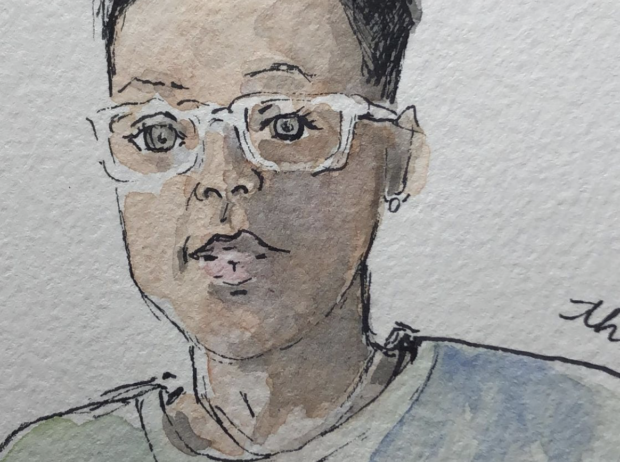Taking a deep breath as I stepped through the entrance doors to the Armory Show, I braced myself for the inevitable feeling of art overload I was about to experience; for me, each booth merges with the next, resulting in a shopping mall vibe that seems anathema to a productive viewing experience. But, let’s face it, this is exactly what an art fair should be, right?
According to Jerry Saltz, a self-proclaimed lover of all things art-related, art fairs aren’t about the art at all. They’re about the people. So he claimed in a talk entitled “LIKE, SWIPE AND DOUBLE TAP: Visual Criticism in the Digital Age,” moderated by Benjamin Genocchio, Executive Director of the Armory Show. Leave it to Saltz, known for never pulling his punches, to alleviate some of the commercial art world ridiculousness … or so I thought. The following is a response to one of the most ludicrous ‘talks’ I’ve attended in a long while. (Disclaimer: Devoted Saltz fans should stop reading now, if only to save themselves the indignation for more important battles, like social media censorship.)
When asked to describe my feelings about art fairs I usually reply with general disdain, laced with stronger feelings of actual disgust. I know many art historians, perched on our intellectual high horses, feel the same way about the overt commodification of art. Such fairs seem to suggest that artworks are best marketed as swank luxury goods or smart financial investments but not cultural treasures. Is this a just assessment? Probably not, given that we are all, even those members of the hallowed academy, proponents of the art market, whether we intend it or not. My morality may also be somewhat compromised for even attending the fair (though I did so on a free day pass; heaven forbid actually paying to go!).

Back to Saltz. His opened with a projection of an Instagram photo of an enormous pig in a tiny cart, whose gigantic testicles could be seen dangling off the back. Below, its caption read:
“Just saw Larry Gagosian’s VIP limo arrive at London’s #FriezeArtFair. Art Ship in splinters.”
Is it any wonder everything went downhill from here? After questioning Saltz on his feelings about the use of social media to invert the traditional model of criticism, moderator Benjamin Gennochio said very little for the remainder of the talk, leaving the floor open for Saltz to pontificate ceaselessly about the most superficial of art matters. Distilling his numerous statements about the financial hardship facing art critics today and the emotional pain inflicted on him by readers who respond with ‘yawn’ to his Facebook posts, I have concluded that the entire lecture could be recategorized as a Saltzian therapy session.
One of the rare highlights of Saltz’s soliloquy was when he dramatically pulled a ‘bank statement’ from his pocket. Holding it aloft, he made a pronouncement about the meager state of his finances—the account holds less than $4,000—with the impish exclamation, “If I even get psoriasis I’m fucked!” Queue lots of laughter. Less so from me, the broke graduate student.
Takeaway: critics don’t get paid much. Go figure. This wasn’t news to me, or anyone else in the room I’m sure, who likely also struggle to make a living in the underfunded, mostly non-profit art world. Instead I was hoping, as I imagine the other attendees were too, to hear a meaningful dialogue about the rapid transformation of art criticism, and how we can productively contribute to a field in which tweets and Instagram posts seem to dominate. Instead we got antics and crass social media jokes. Charming.
There were, it should be noted, brief interludes where Saltz’s self-pity gave way to a more energizing call to arms: for critics to have the conviction to put their opinions out there, to be forceful and brave enough to “dance naked in public,” consequences be damned. But even this felt slightly trite from the mouth of a man who stated, almost in the same breath, “There is no such thing as writing, only re-writing.” If the latter statement is true, and I have to say I’m inclined to agree, then what exactly does it mean to put oneself ‘on the line’ for art criticism? And, following Saltz’s example, do we really think this can be achieved by posting hundreds of sexually explicit pictures? At what point does freedom of expression succumb to narcissistic attention-seeking? By now, I think you know what my answer would be.
Suffice it to say, I left the talk feeling shortchanged. What could have been an intelligent, insightful commentary on the use of visual imagery in criticism today, resulted in what felt like a mediocre comedy skit (despite my best efforts, even I laughed a few times – the man is funny!). Perhaps I was naïve to have expected anything more. In many ways this was a perfect talk for The Armory Show—the art market thrives off the exposure provided by social media platforms, so who better to assess the state of criticism today than the man who makes a living from his role as an online caricature? As Saltz says, “all you have to do is exhibit it and people will come.” Simple, right?




You should have been up there as moderator! 🙂 and Observor~ excellent writing here, Eloise. Thank you for sharing.